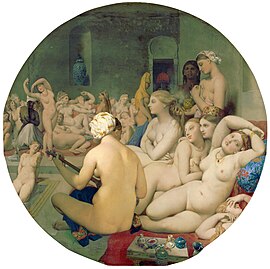
Back الحمام التركي (لوحة) Arabic الحمام التركى ARZ Turkafe kolavaxe (trutca ke Ingres) AVK Türk hamamı (Enqr) Azerbaijani El bany turc Catalan Das türkische Bad German Το Τουρκικό Λουτρό Greek El baño turco Spanish Türgi saun (Ingres) Estonian Bainu Turkiarra Basque
| The Turkish Bath | |
|---|---|
| French: Le Bain turc | |
 | |
| Artist | Jean-Auguste-Dominique Ingres |
| Year | 1852–59, modified in 1862 |
| Medium | Oil on canvas glued to wood |
| Dimensions | 108 cm × 110 cm (42 1/2 in × 43 5/16 in) |
| Location | Musée du Louvre, Paris |
| Accession | R.F. 1934 |
The Turkish Bath (Le Bain turc) is an oil painting by Jean-Auguste-Dominique Ingres, initially completed between 1852 and 1859, but modified in 1862.[1] The painting depicts a group of nude women at a pool in a harem.[1] It has an erotic style that evokes both the Near East and earlier western styles associated with mythological subject matter. The painting expands on a number of motifs that Ingres had explored in earlier paintings,[1] in particular The Valpinçon Bather (1808) and La Grande odalisque (1814) and is an example of Romanticism.
The work is signed and dated 1862, when Ingres was around 82 years old.[2] He altered the original rectangular format and changed the painting to a tondo. A photograph of its original state, taken by Charles Marville, survives.[3]
- ^ a b c "The Turkish Bath". Louvre. Retrieved 18 July 2018.
- ^ Rosenblum, Robert (1999). "Ingres's Portraits and their Muses". In Tinterow, Gary; Conisbee, Philip (eds.). Portraits by Ingres: Image of an Epoch. New York: Metropolitan Museum of Art. p. 126.
- ^ Rosenblum, Robert (1999). "Ingres's Portraits and their Muses". In Tinterow, Gary; Conisbee, Philip (eds.). Portraits by Ingres: Image of an Epoch. New York: Metropolitan Museum of Art. p. 128.